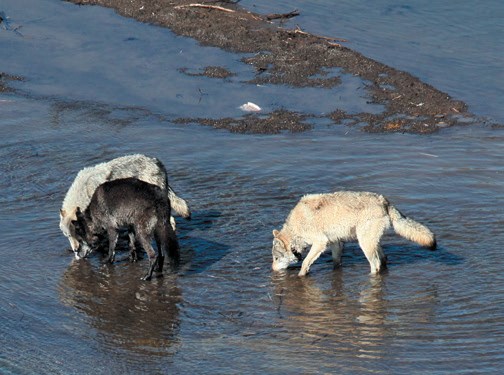...while managing a wolf/bear-jam at the south end of Gibbon Meadows, we observed a member of the Canyon pack capturing and consuming a trout in the Gibbon River.
Article
Wolf Predation on Trout in the Gibbon River

from Yellowstone Science 22(1)
by Daniel Bergum and Nate Bowersock
Throughout their range in North America, gray wolves (Canis lupus) prey primarily on bison, moose, elk, and deer (Mech and Boitani 2003). Although ungulates are the primary prey for wolves, they also consume fish in some regions (Darimont et al 2003). Consumption of fish by wolves has not been documented in Yellowstone National Park since the reintroduction of wolves to the area in 1995-96 (Metz et al. 2012). However, while managing a wolf/bear-jam at the south end of Gibbon Meadows, we observed a member of the Canyon pack capturing and consuming a trout in the Gibbon River.
On August 7th 2013, the Canyon pack killed an elk along the Gibbon River near Gibbon Meadows in the west central part of Yellowstone. The wolves were observed feeding on the elk carcass throughout most of the day and only a small sub-adult grizzly bear and an occasional bald eagle were seen scavenging on the carcass. We returned to the kill early on August 8th to watch for the wolves’ possible return and monitor any bear activity in the area. As we arrived, the white colored alpha female of the Canyon pack was seen traveling south away from the carcass; we assumed she had just finished feeding. About 20 minutes later the black colored alpha male and two gray yearling wolves were seen approaching from the north heading toward the elk carcass in the river. One of the yearlings crossed the river and started feeding while the other two wolves sat and watched from the shore. At about 11 a.m. the two yearlings switched places at the carcass. The first yearling to feed grabbed a piece of the carcass and went across to the opposite shore to finish eating. After the yearling finished feeding on the piece of elk, we observed, in the company of onlookers, the yearling jump into the river and return to shore with an approximately 12-inch long fish in its mouth. The wolf was observed eating the head first, then swallowing the remaining portion whole. Although the species of fish could not be identified, rainbow, brown, and brook trout inhabit that area of the Gibbon River. This may be the first documentation of a wolf predating on a fish in Yellowstone. We cannot confirm whether or not the fish was actually killed and eaten or if it was already dead and opportunistically scavenged upon.
Wolves have been documented feeding on salmon in coastal British Columbia. Using stable isotope analysis from feces, wolves showed a dietary shift from ungulates to salmon, especially in areas where salmon were abundant (Darimont et al. 2008). In areas where ungulate populations are in low densities, and spawning salmon occur, wolves could be expected to consume them as a valuable food source (Adams et al. 2010). While fish species are not believed to be a significant food source for Yellowstone wolves, this observation demonstrates their opportunistic foraging behavior.
Literature Cited
Adams, L. G., S. D. Farley, C. A. Stricker, D. J. Demma, G. H. Roffler, D. C. Miller, and R. O. Rye. 2010. Are inland wolf-ungulate systems influenced by marine subsidies of Pacific salmon? Ecological Applications 20(1):251-262.
Darimont, C. T., P. C. Paquet, and T. E. Reimchen. 2008. Spawning salmon disrupt trophic coupling between wolves and ungulate prey in coastal British Columbia. BMC Ecology 8(1):14.
Darimont, C. T., T. E. Reimchen, and P. C. Paquet. 2003. Foraging behavior by gray wolves on salmon streams in coastal British Columbia. Canadian Journal of Zoology 81(2):349-353.
Mech, L.D. and L. Boitani. 2003. Wolf: Behavior, Ecology, and Conservation. University of Chicago Press, Chicago, Illinois, USA.
Metz, M. C., D. W. Smith, J. A. Vucetich, D. R. Stahler, and R. O. Peterson. 2012. Seasonal patterns of predation for gray wolves in the multi-prey system of Yellowstone National Park. Journal of Animal Ecology (81)3:553-563.
Last updated: April 21, 2025
